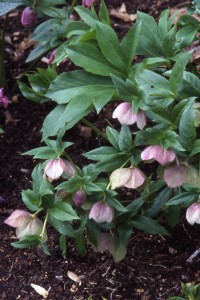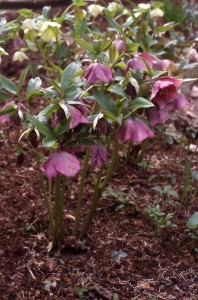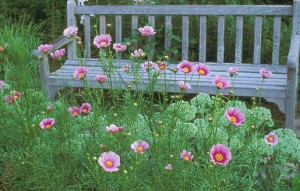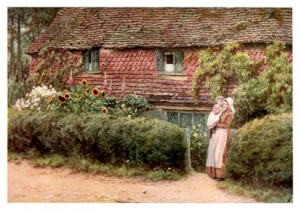Spring Blooming Shade Plants: Hellebores
March 18, 2009 by admin
Filed under Perennials, Shade Gardening, Spring Bloomers
In a typical year, hellebores will be the first ornamental perennial to bloom in the Northeast. Although there are several species that can be grown in this region, especially in milder areas such as the coast and the lower Connecticut River Valley, one of the hardiest remains my favorite: Helleborus x hybridus (formerly and sometimes still known as Helleborus x orientalis).

Helleborus x hybridus
Here in northwest Connecticut, hellebores send up their flower buds first, in March, before their leaves unfurl. As the month goes on, these succulent and tender looking shoots grow taller and taller, until they finally open up around April 1 to reveal clusters of 2″-wide, pendant blossoms. The species H. x hybridus is quite variable, with a range of subtle flower colors including creamy white, apple green, pale pink and burgundy. Its flowers often have striking speckled markings and prominent yellow anthers that are showy for about a week until the stamens fall off.
At first, hellebore flowers look a bit undressed because the plant’s leaves don’t come along until a few weeks later. When they do make their appearance, however, they are exceptionally attractive—leathery, glossy, palmate (arranged like fingers around the palm of a hand) and semi-evergreen.

Hellebore flowers emerge before leaves
Everything about hellebores is long lasting. Instead of dropping off after 2-3 weeks, hellebore flowers slowly fade to a pale green or buff color in much the same way hydrangea flowers do. They look good (although subdued) right up to the point when the seeds mature and are dispersed, usually in the latter half of June. Deadhead them before that point unless you want seedlings the following spring. In most gardens, the leaves will remain disease free and unblemished all season long, and will still be looking good when the first snow flies.
Shade tolerance: High
Hardiness: Zone 5; other species may differ
Size: Medium sized, with a height and spread of 15-18″
Native status: non-native to any part of North America
Growing Tips
- Don’t cut back hellebore foliage in fall, even if you clean up the rest of your garden then. Why? Hellebores come up so early in the year, they are subject to damage from late frosts. These frosts won’t kill the plants, but they will kill the flower buds. As the plant’s shoots begin to emerge from the ground, last year’s leaves will provide some protection. After the new shoots have grown taller than last year’s leaves, you can groom them, cutting off the old foliage at ground level. Be careful not to accidentally cut off new growth—it’s easy to do. For a few more weeks after you groom them, it’s a good idea to keep some pine boughs or an equivalent handy to gently arrange over the new growth at night if a hard frost is in the forecast.
- Hellebores have to be several years old before they are mature enough to flower. A nursery plant in a 5-pint pot is probably only two years old, so don’t be surprised if it doesn’t flower its first (or even second) year in the ground. As long as the plant grows well and looks healthy, flowering should start when the plant is ready. A plant that fills a one-gallon pot should be old enough to flower its first spring after planting.
- H. x hybridus is often sold in a mix of undifferentiated colors. In other words, if the tag in the pot with your plant does not specify a flower color, but just says H. x hybridus, it could be any of the flower colors listed above. There’s no way to know which color you’ve got unless you buy the plant in bloom very early in the season and the plant is old enough to be blooming in the first place. In recent years, some growers have also offered hellebores in designated colors. I like the way the mixed colors look in the garden when hellebores are massed, but gardeners with color-theme gardens might prefer to purchase all of one kind.
- Hellebores have no special needs, but they don’t like excessive moisture. If put in exceedingly dank locations or planted in soils that drain poorly, rot of the crown may result.
- Hellebores self-sow moderately. Their seeds are large and heavy, so they don’t usually travel very far. If you don’t deadhead your plants before they drop their seeds, you’ll probably find a “skirt” of seedlings around their feet in spring. Move these to a nursery bed to mature or give them away to friends.
Bloom times and other life cycle stats are accurate for northwest Connecticut. In milder areas all aspects of a plant’s life cycle may occur earlier in the year, and in colder areas, later.
Captivating Cottage Gardens
March 18, 2009 by admin
Filed under Cottage Gardening, Garden Design
Cottage gardens possess an allure unmatched by any other kind of garden. Maybe it comes from being the horticultural equivalent of a woman with an hourglass figure, or maybe it’s just because they’re packed with such a variety of plant life that they’re never the same two weeks in a row, but whatever the source of their mystique, cottage gardens draw people like bees to nectar.

Cosmos takes center stage in a sweet cottage garden scene
This spring I’m giving a series of lectures about cottage gardening, focusing primarily on a very particular cottage garden I designed and built starting in 2000. At nine years of age, it’s had plenty of time to mature and evolve. Many good gardening lessons can be drawn from it, and I’ll be sharing them with you over the coming months.
If you’re in (or plan to be in) southern New England this spring, check out my lecture schedule to see if you can’t fit one into your plans. Most of them are free, and you can’t do better than that!
To get things started, I’ll just say a few words about what a cottage garden is. The origins of the cottage garden go back hundreds of years to a time when most people grew a significant amount of their own food and made a great deal of their own household products—from soaps and dyes to medicines—mostly from plants. Cottage gardens are named for the country cottages around which they were found. Although cottage gardens as a phenomenon certainly weren’t restricted to the British Isles, we did inherit the cottage gardening tradition primarily from the British by virtue of our shared history.

An artist's depiction of a traditional British cottage garden
Several things characterized the traditional cottage garden. It was on the small side, informal and not “designed” in anything like the modern sense of the word; it was a garden belonging to a person of modest means; it was a mix of flowers, vegetables and herbs (although the word “herb” meant something different then—more on that later); the plants in it were procured cheaply, usually in the form of passalong cuttings, divisions and seeds from friends and family; and it was densely packed with plants in order to maximize the productivity of a limited space.
Today’s cottage gardens are often strictly ornamental, vegetables and herbs now having their source at the local grocery store. They can be large, upscale and filled with the most fashionable of exotic vegetation, or they can be spaces where every resident plant carries an association with a loved friend or relative who gave it as a gift. Despite these differences, cottage gardens still look a lot like their ancestors—a testament to the adaptability of a loosely defined garden style. In fact, the only real requirements for a cottage garden are that it have a blowsy, freewheeling look and a lot of different flowering things.
That’s all for now—I hope you’ll join me over the coming months as we look in depth at how to make captivating cottage gardens.

